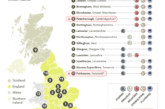
BSI Identify’s whitepaper series continues with a document that reveals how digitalisation and breakthrough technology can ensure the built environment benefits from the circular economy.
Authored by Dr. Seyed Ghaffar, Associate Professor in Civil Engineering at Brunel University in London and Paul Mullett, Group Engineering and Technology Director at Robert Bird Group, ‘Completing the Circle — How Digitalization will Unlock Circular Construction’ is now available to view online.
Ross Matthews, Head of Sales at BSI Identify said: “The circular economy is crucial to creating a more sustainable built environment. Transformative technologies, such as product ID, can play a part in this process. Traceable assets or materials allow immediate access to a range of vital information which could assist with the recycling process. This whitepaper highlights how the built environment is best-placed to exploit the circular economy, with smarter working practices being key to a less-carbon intensive construction sector.”
The aim of the circular economy is to improve sustainability by changing the end-of-life concept with reducing, reusing, recycling and recovering materials during the consumption process. However, as this whitepaper highlights, the circularity culture is often stymied in relation to its use within the building sector. Lack of effective stakeholder communication and unknown product performance capability are cited among the reasons for the lack of progress. Communication technologies (ICT), and the development of digital collaboration platforms are seen as key to leveraging the circular economy’s influence on building design and construction.
In their excellent thought leadership analysis, Dr. Seyed Ghaffar and Paul Muller look at the challenges of implementing breakthrough technology whilst highlighting how it can support circular economy-based decision-making and create opportunities for innovation in the built environment sector.
Ross Matthews continued: “This whitepaper is essential reading for advocates of sustainable building via environmental quality, economic prosperity, and social equity to the benefit of current and future generations. We thank Dr. Seyed Ghaffar and Paul Muller for their expert input. They’ve helped create an enlightening document that is sure to become an industry talking point.”
BSI Identify
BSI recognises the growing demand within the built environment sector for digital systems that enable traceability of construction products. In response, it created ‘Identify’ — an innovative service that leverages established digital technology to deliver reliable long-term access to product information. By utilising this technology, specifiers and installers have instant access to reliable and accurate product data on a dependable basis.
BSI has been working with industry partners to diligently develop BSI Identify since 2015, resulting in the creation of the persistence product registry and its Universal Persistent Identification Number (UPIN) for construction products. This unique and networked identifier unlocks essential information, allowing the supply chain, asset managers and end users to quickly retrieve details such as accreditations, data sheets or user guides through their mobile phones or laptops.
Whether you’re an engineer inspecting a high-rise building or a subcontractor responsible for installing a façade system, having products or materials that are digitally logged with UPIN provides immediate access to crucial information. This ensures that the specified products are indeed being installed.
Manufacturers equipped with product identification capabilities are poised to stay ahead of the curve, as the industry moves towards enhanced asset traceability. Larger housebuilders are already recognising the value of this transformation, as it brings significant benefits to their business, supply chain partners and property occupants.
To view or download a copy of ‘Completing the Circle – How Digitalization will Unlock Circular Construction’ click here.









